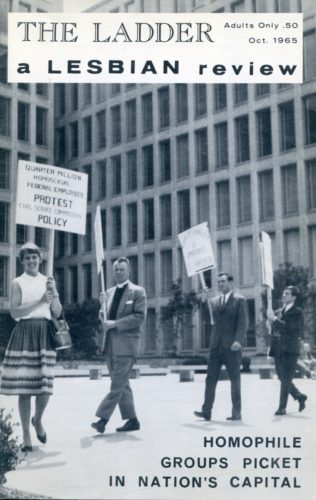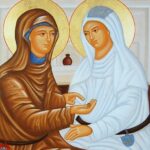Last Updated on July 3, 2024 by Kittredge Cherry
Early LGBTQ rights protests happened every Fourth of July from 1965 to 1969 in front of Independence Hall in Philadelphia. Among the protesters was Robert W. Wood, the first member of the clergy to picket for LGBTQ rights.
The events were called Annual Reminders because they aimed to remind the public that “homosexual Americans” were denied the rights to “life, liberty, and the pursuit of happiness” as guaranteed in the U.S. Declaration of Independence.
American patriotism mixed with LGBTQ rights at the Annual Reminders, which preceded and paved the way for the Stonewall Uprising. The date and location were strategically planned to connect LGBTQ rights with other American freedoms.
The demonstrations happened on Independence Day at Independence Hall, where the Declaration of Independence and the Constitution were written. It was also the home of the Liberty Bell, the iconic symbol of American independence inscribed with the message, “Proclaim liberty throughout all the land unto all the inhabitants thereof.” Abolitionists and suffragettes also used the Liberty Bell as a logo.
The Annual Reminders were a collaboration of the East Coast Homophile Organizations (ECHO). The primary organizers were LGBTQ rights pioneers Frank Kameny and Barbara Gittings. Her partner Kay Tobin Lahusen narrates a video with footage of the actual 1968 Reminder demonstration.
Forty gay men and lesbians from Washington, D.C., Philadelphia and New York picketed at the first Annual Reminder in 1965. At the time it was the largest demonstration for LGBTQ rights in world history. According to Outhistory.org, Wood attended the Annual Reminders every year from 1965-69. The demonstrations kept growing bigger. The rest is history.
Another ground-breaking participant was Ernestine Eckstein (April 23, 1941 – July 15, 1992), a lesbian activist who was one of the only women — and the only black woman — present at early LGBTQ rights protests such as the Annual Reminders.
 Religion tends to get downplayed in LGBTQ history, but the role of Wood and other church leaders is reclaimed in “Reforming Sodom: Protestants and the Rise of Gay Rights” by religion professor Heather Rachelle White. She challenges the prevailing LGBTQ secular narrative and recovers the forgotten history of liberal Protestants’ role on both sides of the debates on sexual orientation and identity.
Religion tends to get downplayed in LGBTQ history, but the role of Wood and other church leaders is reclaimed in “Reforming Sodom: Protestants and the Rise of Gay Rights” by religion professor Heather Rachelle White. She challenges the prevailing LGBTQ secular narrative and recovers the forgotten history of liberal Protestants’ role on both sides of the debates on sexual orientation and identity.
Minister Robert Wood picketed in his clergy collar
Robert W. Wood (1923-2018), an ordained Congregational minister, wore his clergy collar while picketing for LGBTQ equality. This gay-rights pioneer also wrote America’s first book on homosexuality and Christianity.

Rev. Robert Wood and others are shown picketing for LGBTQ rights in 1965 on the cover of The Ladder.
Wood can clearly be seen picketing in his clergy collar on the cover of the October issue of “The Ladder,” the first national lesbian publication in the United States. The headline says, “Homophile groups picket in nation’s capital.” The photo credit on page 3 adds, “Front cover photo by Eva. Taken at the picketing at Civil Service Commission Building, Washington, DC, on June 26, 1965. This picture shows four of the 18 men and 7 women who took part in the march to protest the Civil Service Commission’s policies on homosexuals.” One of the protest signs reads, “Quarter million homosexual federal employees protest Civil Service Commission policy.”
 “Christ and the Homosexual” was published in 1960 under Wood’s own name with his photo on the dust jacket, even though friends and colleagues warned him that this would damage his reputation. The book calls for the church to welcome homosexuals, recognize same-sex marriage and ordain homosexual clergy.
“Christ and the Homosexual” was published in 1960 under Wood’s own name with his photo on the dust jacket, even though friends and colleagues warned him that this would damage his reputation. The book calls for the church to welcome homosexuals, recognize same-sex marriage and ordain homosexual clergy.
In 1962 Wood met his life partner Hugh M. Coulter, an abstract artist, cowboy and a fellow World War II veteran. They lived together as a couple while Wood served as pastor of three different parishes over the next 27 years until Coulter’s death. Now age 93, Wood is retired and living in New Hampshire.
Wood’s LGBTQ Christian message is still powerful today. As he wrote in “The Church and the Homosexual” in 1960:
The Church has done much to keep the homosexual from Christ. Society, often under the influence of the Church, has also thrown roadblocks in the pathway of the homosexual who seeks a higher purpose in life beyond the sexual plane of pleasurable existence.
But the struggle is difficult, the motives misunderstood, the behavior pattern considered perverted. Yet Jesus Christ, whose struggle was also difficult, whose motives were also misunderstood, whose behavior pattern was revolutionary, awaits all men — even the overt homosexual.
In the book, he comes to a powerful conclusion:
The basic point is that the saving message of Christ and the freely flowing grace of God are as much for the homosexual as the heterosexual; that the Church must minister equally to both; that the demands of Christ apply to both; that both are capable of being moral, as well as immoral and amoral.
___
Related links:
Rev. Robert Wood, gay rights pioneer, dies at age 95 (Q Spirit)
Annual Reminder (Wikipedia)
To read this article in Italian, go to:
Padre Robert Wood, un pastore gay in lotta per i diritti delle persone LGBT (Gionata.org)
Books on LGBTQ American history
A Queer History of the United States for Young People by Michael Bronski, adapted by Richie Chevat. (Suitable for adults too.)
“A Queer History of the United States” by Michael Bronski
“Stand by Me: The Forgotten History of Gay Liberation” by Jim Downs
“Gay American History: Lesbians and Gay Men in the U.S.A.” by Jonathan Katz
___
Top image: Barbara Gittings at the Annual Reminder in 1966
____
This post is part of the LGBT Calendar series by Kittredge Cherry at the Jesus in Love Blog. The series celebrates religious and spiritual holidays, holy days, feast days, festivals, anniversaries, liturgical seasons and other occasions of special interest to lesbian, gay, bisexual, transgender and queer people of faith and allies.
This article was originally published in July 2017 and was checked for accuracy on July 4, 2021.
Copyright © Kittredge Cherry. All rights reserved.
http://www.jesusinlove.blogspot.com/
Jesus in Love Blog on LGBT spirituality and the arts





















Trackbacks/Pingbacks